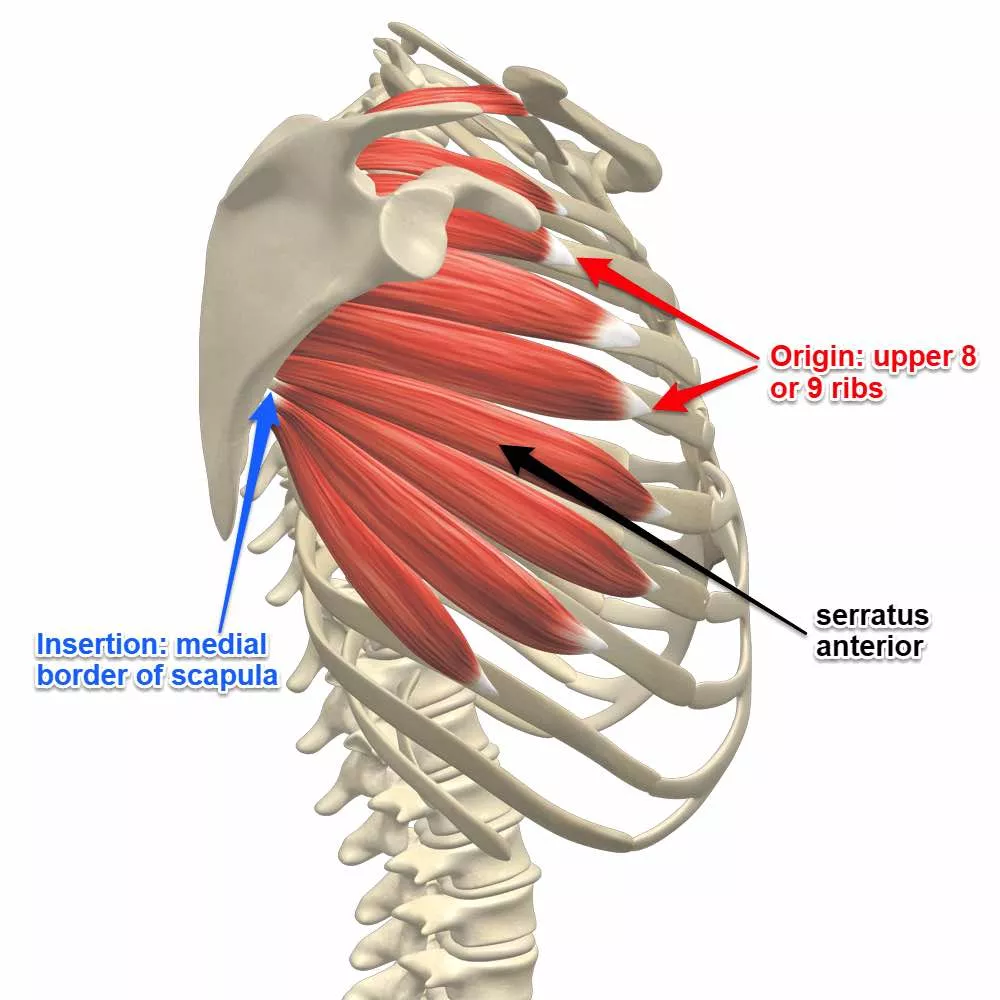The serratus anterior not only makes your abdominal area more attractive but also helps improve your shoulder stability and overall athletic performance.
In this article, we’ll dive into the anatomy and function of the Serratus Anterior muscle and the importance of strengthening it. We’ll also discuss the best serratus anterior exercises and how to incorporate them into your workout routine to progress faster.
Anatomy and Function of the Serratus Anterior Muscle

The serratus anterior muscle is located on the lateral aspect of the chest and underneath the trapezius muscle. It originates from the first to ninth ribs and inserts onto the medial border of the scapula (shoulder blade). [1] [2]
Serratus anterior is critical in stabilizing the scapula and facilitating upward rotation during arm elevation. It also contributes to the protraction and retraction of the scapula, which is essential for activities that require reaching and pushing. [3]
So, by performing exercises that involve protraction and upward rotation of the scapula, we can improve the strength and stability of this muscle.
Importance of Strengthening the Serratus Anterior Muscle
Strengthening the serratus anterior muscle is crucial for several reasons. First, it helps to improve your scapular stability, further promoting shoulder function. Strong serratus anterior can also help prevent scapular winging, typically due to muscle weakness or injury. [4]
Studies have also shown that strengthening the serratus anterior can be beneficial for individuals with shoulder pain or dysfunction. In a randomized controlled trial, it’s proven that individuals who underwent an exercise program targeting the serratus anterior muscle had significant improvements in pain, function, and scapular positioning compared to those who didn’t work out. [5]
Furthermore, strengthening this (serratus anterior) muscle can enhance athletic performance and range of motion, particularly in overhead movements such as throwing, swimming, or weightlifting. [6]
10 Best Serratus Anterior Exercises
Here are 10 of the best serratus anterior exercises.
1. Scapular Push-up
The push-up exercises are proven to be highly effective in targeting the serratus anterior muscle fibers. [7]
The scapular push-up is a great variation and helps activate and strengthen the serratus anterior muscle.
How to do it:
- Start in a high plank position with your hands on the ground, slightly wider than shoulder-width apart.
- Lower your chest towards the ground while maintaining a straight line from head to heel.
- As you push back up, protract your shoulder blades by pushing your upper back toward the ceiling.
- Then, bend your elbows, lower your body to the starting position, and repeat.
Tip: Keep your elbow at your side at a 45-degree angle and avoid shrugging your shoulders.
2. Wall Slide
One study compared different exercises and found that the serratus anterior was most active during the wall slide exercise [8]. It also helps improve your scapular mobility and posture.
How to do it:
- Stand with your back against a wall and your feet slightly away from the wall to support your upper body.
- Raise your arms to a shoulder height level with your elbows bent at 90 degrees and your forearms against the wall.
- Then, slide your arms up the wall, maintaining contact between your forearms and the wall.
- Lower your arms to the starting position and repeat for desired reps.
Tip: Avoid too much arch in your lower back by engaging your core.
3. Plank with Shoulder Tap
Plank with shoulder taps engages the serratus anterior and promotes core stability and shoulder strength. It’s also a great exercise for the front deltoid.
How to do it:
- Start in a high plank position with your hands on the mat directly under your shoulders and your body in a straight line.
- Keeping your core tight, lift one hand off the ground and tap the opposite shoulder.
- Then, place the hand back on the ground and repeat with the other hand.
- Continue alternating shoulder taps for the desired reps.
Tip: Maintain a stable plank position throughout the exercise. You can place your legs on a bench or high surface as your progress.
4. Standing Serratus Punch
This explosive punching movement effectively trains the serratus anterior and enhances your scapular stability and punching power.
How to do it:
- Stand with your feet slightly apart and knees slightly bent.
- Start with the hands in front of your chest, fists clenched, and keep your core engaged.
- Punch one arm forward, extending it fully while protracting the shoulder blade (bringing the scapula away from the spine).
- Then, retract your arm back to the starting position and repeat with the other arm.
- Continue alternating punches as desired reps.
Tip: Focus on generating power from your shoulder and serratus anterior rather than just using your arm.
5. Alternating Dumbbell Punch
The dumbbell punches are similar to regular punches, but here you’ll use dumbbells to get more tension on the targeted muscle group. It’s a great exercise for building the serratus anterior and increasing your upper body strength.
How to do it:
- Stand with your feet shoulder-width apart, holding a dumbbell in each hand.
- Start with your hands near your chest, fists clenched. Keep your core tight and look in the front.
- Punch one arm forward, extending it fully simultaneously, protracting the shoulder blade of the same side.
- Then return your arm to the starting position and do the same with the other arm.
- Continue alternating your arms as desired reps.
Tip: Keep your body still throughout the exercise. Use lighter weights initially and gradually increase the weight as you get stronger.
6. Serratus Anterior Raise
Serratus anterior raises specifically target the serratus anterior, improve scapular stability and strengthen the muscle.
How to do it:
- Lie on your back on a bench or mat with a light dumbbell in each hand.
- Extend your arms straight above your chest, palms facing each other. Keep your core tight and feet flat on the ground.
- Keeping a slight bend in your elbows, lower the dumbbells out to the sides in a wide arc.
- As you lower the dumbbells, focus on protracting your shoulder blades and engaging your serratus anterior.
- Then, raise the dumbbells to the starting position and repeat.
Tip: Use light to moderate weights to ensure proper form and build mind-muscle connection.
7. Dumbbell Pullover
Although we typically use the dumbbell pullover to train the lats and chest, you should know that it’s also a very good exercise for activating the serratus anterior muscles.
How to do it:
- Lie on a bench with your head at one end and your feet planted firmly on the floor.
- Hold a dumbbell with both hands and extend your arms above your chest.
- Keeping a slight bend in your elbows, lower the dumbbell back and behind your head, maintaining control.
- Pause for a moment, then bring the dumbbell back to the starting position by contracting your serratus anterior muscles.
- Repeat as desired reps.
Tip: Keep your core engaged to stabilize your body and prevent excessive lower back arching.
8. Cable Punch
Here’s another punching variation, and now we will use a cable machine. However, you can also use a resistance band. Using a cable or band helps you increase your range of motion compared to dumbbells.
How to do it:
- Stand with a cable machine in your backside, and set the pulley at shoulder height.
- Grab the handle with one hand and position yourself at a comfortable distance from the machine.
- Stand tall with a stable stance, your feet shoulder-width apart, and your core tight.
- Keeping your elbow slightly bent, punch the cable forward, and fully extend your arm while protracting the shoulder blade.
- Then, slowly return to the starting position and continue alternating your arms.
Tip: Use a manageable weight. Control the cable, especially when returning your arm toward the machine.
9. Cable Diagonal Raise
This exercise activates your shoulders as well as your serratus anterior muscle. It helps increase your shoulder strength and rotational power.
How to do it:
- Stand perpendicular to a cable machine with the pulley set at waist height or bottom.
- Grab the handle with one hand and step away from the machine. Keep your core engaged and maintain an upright posture.
- Starting with the handle positioned near your opposite hip, pull the cable diagonally across your body and overhead, maintaining control.
- Then slowly lower the cable to the starting position. Repeat and switch arms.
Tip: Focus on controlling the movement and feeling the activation in your serratus anterior.
10. Serratus Punch with Band
Here we come to the serratus punch variation, and this time with a resistance (loop) band.
How to do it:
- Stand with your feet slightly apart and attach a resistance band behind your back and hold each side of the band with both hands.
- Now press the band straight out in front of you as you fully extend your arms.
- Keeping your arms straight, push the band further in the front away from the body, rounding through the upper back. You’ll keep your arms extended throughout the movement.
- Then, return your shoulder to the initial position and repeat.
Tip: Keep your core engaged and maintain proper posture throughout the exercise.
Incorporating Serratus Anterior Exercises into a Workout Routine
You can add these exercises to your current routine or use them as a standalone workout to target and strengthen the serratus anterior muscle.
To effectively incorporate serratus anterior exercises into a workout routine, it’s important to choose exercises that target this muscle group in different planes of motion (i.e., sagittal, frontal, transverse) and use various equipment (i.g., dumbbells, resistance bands, and cables) target this muscle group from different angles.
An effective way to incorporate these exercises is to include them in your warm-up (or activation) routine. For example, you can perform the following exercises before your main workout.
- Scapular push-ups
- Wall slides
- Cable diagonal raises
Or you can use the exercises in your main workout itself. Some serratus anterior strengthening exercises are:
- Standing serratus punches
- Alternating dumbbell punches
- Cable punches
Aim for 2-3 sets of 10-12 reps of each exercise in the workout.
In the end, be sure to cool down and stretch the muscle after your workout. One effective stretch you can do is the wall slide stretch, where you hold the position for 15-30 seconds and feel the stretch on your serratus anterior muscle.
Serratus Anterior Exercises for Rehabilitation and Injury Prevention
A study published in the Journal of Orthopaedic & Sports Physical Therapy found that incorporating serratus anterior exercises into a rehabilitation program for patients with shoulder injuries has improved their shoulder function and pain reduction. [9] [10]
Check out some of the best serratus anterior exercises that can be helpful for rehabilitation and injury prevention:
Prone Y, T, and W
These exercises can help strengthen the upper back and shoulder muscles, including the serratus anterior. To perform a prone Y, T, and W:
- Lie face down on a mat with your arms in the respective positions (Y, T, or W).
- Lift your arms off the ground, squeeze your shoulder blades together, and hold for a few seconds before lowering them down.
- Repeat for several reps.
Wall Angels:
This exercise improves your posture and strengthens the serratus anterior.
- Stand with your back against a wall and your arms bent at 90 degrees.
- Slowly slide your arms up the wall, keeping your elbows and wrists in contact with the wall.
- Once your arms are fully extended overhead, slowly lower your arms to the initial position and repeat for several reps.
Foam Roller T-Spine Extensions
This exercise can help improve mobility in the thoracic spine and strengthen the back and shoulders.
- Lie on a foam roller with it positioned along your spine.
- Place your hands behind your head and slowly extend your upper back over the roller.
- Roll through your upper back for 20-30 seconds.
- Make sure you’re avoiding foam rolling your lower back.
Remember, these exercises can also be helpful for individuals recovering from shoulder injuries or those wanting to prevent future injuries.
As always, it’s important to consult with a healthcare professional before starting any new exercise routine, especially if you have any injuries.
Common Mistakes to Avoid When Performing Serratus Anterior Exercises
Here are the common mistakes to avoid when performing serratus anterior exercises:
Rounding the Shoulders
During exercises like scapular push-ups or wall slides, keep your shoulders away from your ears and avoid rounding them forward. This can put unnecessary strain on the neck and shoulders and limit the effectiveness of the exercise.
Overextending the Spine
When performing plank with shoulder taps, keep your spine in a neutral position and avoid excessive curves in the lower back and lifting your hips too high.
Using Too Much Weight
While adding weights to your serratus anterior exercises, make sure you are not using too much weight that prevents your form. It’s always wiser to start with lighter weights and focus on proper form before gradually increasing the resistance.
Neglecting other Muscles
While serratus anterior muscles are important to strengthen, training other commonly neglected muscles, such as rhomboids, middle and lower trapezius, and rear deltoids, is also important.
Shrugging the Shoulders
Most serratus anterior exercises involve shoulder movement, be sure to keep your shoulders back and down (away from your ears) to get the maximum tension on the upper back.
Shrugging the shoulders can activate other muscles (i.e., upper traps and neck muscles) and reduce tension from the targeted muscle group.
Overarching the Lower Back
Another common mistake is arching the lower back during the exercises. This can put unnecessary stress on your lower back, leading to spinal cord injury.
Keep your core engaged and your lower back in a neutral position.
Failing to Engage the Serratus Anterior
One of the biggest mistakes people make when training the serratus anterior muscle is failing to properly engage this muscle during exercises.
You can correct this by focusing on form and consciously engaging the muscle—building the muscle-mind connection.
Bottom Line
So… There we have it: Best serratus anterior exercises.
Incorporating these serratus anterior exercises into your workout routine can help you in numerous ways, as we already know.
Remember to start with basic exercises and progress gradually to more advanced variations as you become comfortable with the moves.
If you have a history of shoulder injuries or pain, consult with a healthcare professional before starting any exercise program.
FAQs About Serratus Anterior Exercises
How often should I do serratus anterior exercises?
It’s recommended to perform serratus anterior exercises 2-3 times per week, with at least 48 hours of rest between sessions. However, it’s important to listen to your body and not overdo it.
How to stretch the serratus anterior?
Some effective serratus anterior stretches are: standing wall stretch, doorway stretch, and foam roller stretch.
These exercises involve reaching overhead and stretching the shoulder blade away from the spine. Hold each stretch for 15-30 seconds 1 to 3 times.
What are the symptoms of a weak serratus anterior?
Weak serratus anterior muscle can lead to several complications, including shoulder pain, winging of the scapula (where the shoulder blade sticks out from the back), and limited shoulder mobility. It can also contribute to poor posture (i.e., rounded upper back), difficulty reaching overhead, and decreased upper body strength.
If you experience any of these symptoms, consult with a doctor to determine the underlying cause and get an appropriate treatment.
Sources:
1. Ludewig, P. M., & Cook, T. M. (2002). Translations of the humerus in persons with shoulder impingement symptoms. The Journal of Orthopedic and sports physical therapy, 32(6), 248–259. https://doi.org/10.2519/jospt.2002.32.6.248
2. Lung K, St Lucia K, Lui F. Anatomy, Thorax, Serratus Anterior Muscles. [Updated 2022 Sep 26]. In: StatPearls [Internet]. Treasure Island (FL): StatPearls Publishing; 2023 Jan-. Available from: https://www.ncbi.nlm.nih.gov/books/NBK531457/
3. Kibler W. B. (1998). The role of the scapula in athletic shoulder function. The American Journal of sports medicine, 26(2), 325–337. https://doi.org/10.1177/03635465980260022801
4. Kibler, W. B., & McMullen, J. (2003). Scapular dyskinesis and its relation to shoulder pain. The Journal of the American Academy of Orthopaedic Surgeons, 11(2), 142–151. https://doi.org/10.5435/00124635-200303000-00008
5. Im, B., Kim, Y., Chung, Y., & Hwang, S. (2016). Effects of scapular stabilization exercise on neck posture and muscle activation in individuals with neck pain and forward head posture. Journal of physical therapy science, 28(3), 951–955. https://doi.org/10.1589/jpts.28.951
6. Ludewig, P. M., & Cook, T. M. (2000). Alterations in Shoulder Kinematics and Associated Muscle Activity in People With Symptoms of Shoulder Impingement. Physical Therapy, 80(3), 276-291. https://academic.oup.com/ptj/article/80/3/276/2842494
7. Kang, F. J., Ou, H. L., Lin, K. Y., & Lin, J. J. (2019). Serratus Anterior and Upper Trapezius Electromyographic Analysis of the Push-Up Plus Exercise: A Systematic Review and Meta-Analysis. Journal of athletic training, 54(11), 1156–1164. https://doi.org/10.4085/1062-6050-237-18
8. Hardwick, D. H., Beebe, J. A., McDonnell, M. K., & Lang, C. E. (2006). A comparison of serratus anterior muscle activation during a wall slide exercise and other traditional exercises. The Journal of Orthopaedic and sports physical therapy, 36(12), 903–910. https://doi.org/10.2519/jospt.2006.2306
9. Mulligan, E. P., Huang, M., Dickson, T., & Khazzam, M. (2016). THE EFFECT OF AXIOSCAPULAR AND ROTATOR CUFF EXERCISE TRAINING SEQUENCE IN PATIENTS WITH SUBACROMIAL IMPINGEMENT SYNDROME: A RANDOMIZED CROSSOVER TRIAL. International Journal of Sports Physical Therapy, 11(1), 94-107. https://www.ncbi.nlm.nih.gov/pmc/articles/PMC4739052/
10. Clark, M., Lucett, S., Eds. (2010) NASM Essentials of Corrective Exercise Training. Lippincott Williams & Wilkins, Philadelphia. https://www.scirp.org/(S(351jmbntvnsjt1aadkposzje))/reference/ReferencesPapers.aspx?ReferenceID=2103909


